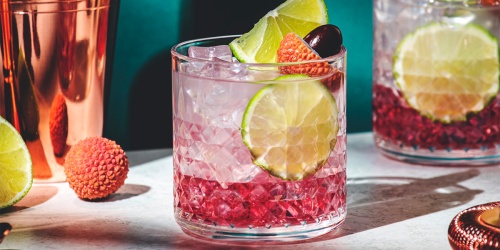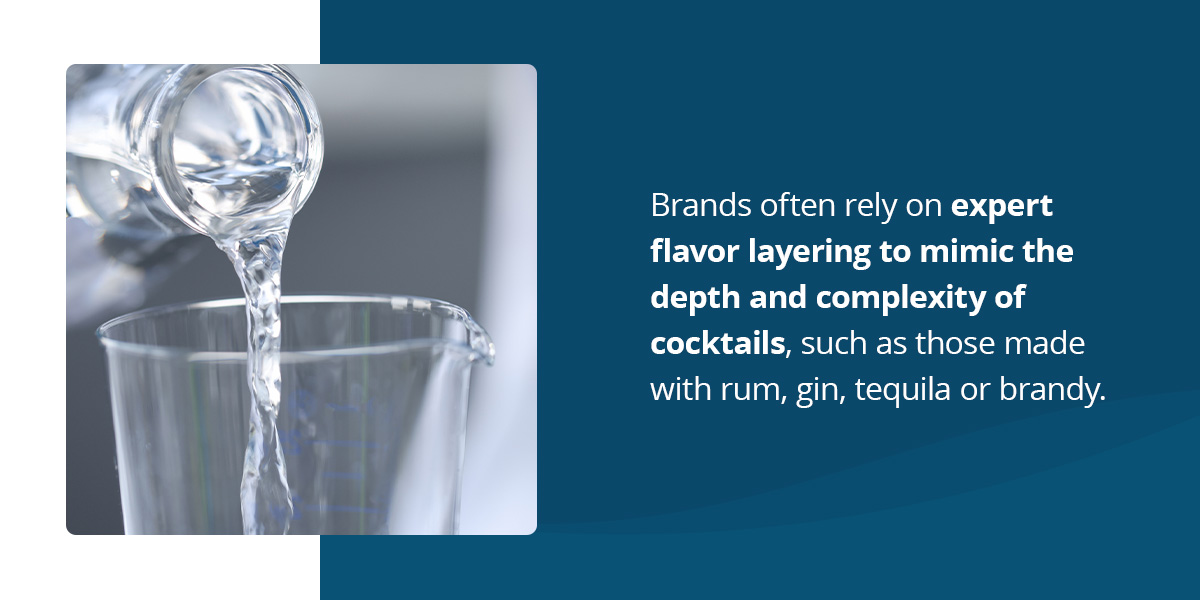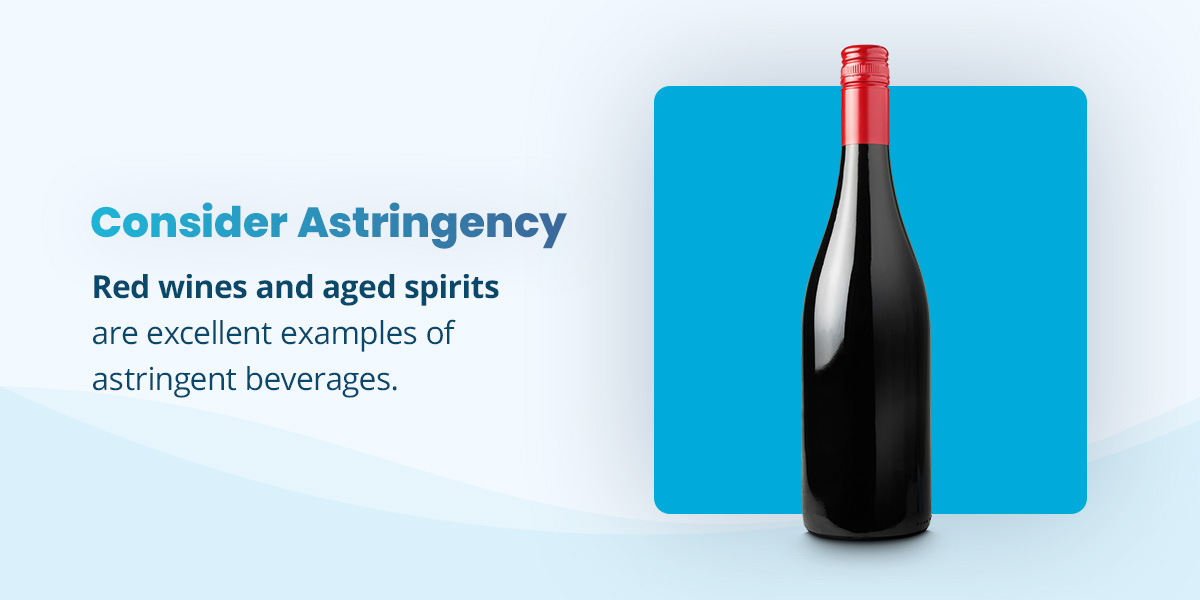Making Mocktails Feel Like Cocktails

More than 40% of Americans strove to drink less alcohol in 2024, which is evidence of a shift in consumer attitudes toward alcohol. Many health-conscious consumers have begun opting for premium, nonalcoholic adult beverages to meet their social needs on their terms. The ready-to-drink (RTD) mocktail market is booming, giving beverage brands an opportunity to meet changing consumer desires and innovate in the mocktail space. Consumers want brands to make mocktails that deliver a cocktail-like experience, and they're open to unique flavor combinations and novel versions of authentic originals.
Creating a "cocktail experience" with a mocktail goes beyond simply omitting alcohol — it's about replicating the sensory and ritualistic elements that make cocktails enjoyable. Knowing how to make mocktails more like cocktails is more important than ever for beverage brands looking to grow in the no- and low-alcohol space. After all, why should a night out without alcohol mean sacrificing the ritual and experience of a well-crafted drink?
The Importance of Mouthfeel
Consumers' relationships with alcohol are changing. Off-premise nonalcoholic drink sales in the United States reached $823 million in 2024, per NIQ. The drinking culture is shifting for several reasons, including a rise in moderate consumption, growing concern about individual health and inflation affecting alcohol prices. Many people want to enjoy the social aspect of having a drink with friends, minus the alcohol. Mocktails have a higher social acceptance rate than ever, allowing consumers to enjoy social events without the side effects.
However, alcohol is more than just a beverage — it's a complete experience. Consumers choosing mocktails want to mimic the experience of having a conventional cocktail, so beverage brands must know how to make mocktails taste like cocktails. Each cocktail consists of flavor, taste and mouthfeel. The best cocktails harmoniously balance these elements to offer an enjoyable experience. If one is out of sync, the whole drink loses its appeal.
Making mocktails with a mouthfeel of alcohol is one of the most crucial considerations in formulating RTD mocktails. Most mocktail consumers are familiar with conventional cocktail choices and expect to enjoy a nonalcoholic beverage with similar complexity. They'll notice the lack of ethanol, which presents new challenges and opportunities for beverage brands.
To formulate mocktails that feel like cocktails, beverage brands must capture the emotional experience of drinking a cocktail. They can focus on developing beverages that mimic ethanol's characteristic burn profile by researching and innovating to better understand the formulations available to them. In doing so, they inch closer to formulating a nonalcoholic drink that delivers the identifiable burn, fragrance and taste of conventional cocktails.
Challenges in Making Mocktails Feel Like Cocktails
The process of making mocktails like cocktails is complex. Simply omitting alcohol can lead to several formulation challenges that brands must navigate.
1. Replicating Alcohol's Sensory Qualities in Mocktails
Consumers seek mocktails as a way to enjoy the flavors and experiences of conventional cocktails. While they're open to new flavor experiences, they also expect mocktails to exhibit a familiar taste and mouthfeel. The goal is to develop a beverage that stands independently as a satisfying, enjoyable, premium alternative rather than a pale imitation. Replicating the body, warmth and astringency of cocktails is crucial yet challenging. Without alcohol, mocktails can often become overly sweet or flat, lacking the complexity that consumers expect.
The absence of alcohol introduces additional formulation challenges. Beverage brands must carefully balance ingredients to achieve the desired mouthfeel and taste while ensuring that the formulation remains stable over time. Without alcohol’s preservative properties, mocktails are also more vulnerable to microbial spoilage, flavor degradation and reduced shelf life. To maintain product quality, brands must thoughtfully select ingredients and processing methods that preserve the sensory experience and enhance longevity.
2. Developing the Characteristic Flavors of Common Ingredients

One of the most challenging aspects of mocktail formulation is accurately mimicking the flavors of common liquors. Many liquors are highly regulated regarding the processes and materials that qualify them for labeling, from the barrels in which they are aged to the ingredients used to distill them. Bourbon cocktails are a prime example of complex and nuanced flavor profiles that are immensely challenging to replicate.
Replicating the taste of traditional spirits and liqueurs is a central challenge in crafting convincing nonalcoholic cocktails. Brands often rely on expert flavor layering — using juices, botanicals, spices and other natural ingredients — to mimic the depth and complexity of cocktails, such as those made with rum, gin, tequila or brandy. Others turn to specialized spirit and liqueur flavorings developed by professional flavor houses. For example, you could use a tequila flavoring with lime and orange to mimic a margarita.
These expertly formulated blends, available in both natural and artificial options, are tailored specifically for beverage applications and designed to evoke the distinctive profiles of well-known liquors. Mastering these flavors is key to winning over consumers and often requires the guidance of an experienced formulation expert.
3. Perfecting the Sensory Aspects of Popular Cocktails
Cocktails are a sensory experience, from the vivid color combinations to the irresistible aromas and characteristic mouthfeel. Mimicking alcohol's warmth, burn and astringency in mocktails is technically challenging and often requires the use of mouthfeel enhancers, carbonation or functional ingredients to simulate the sensation of drinking classic cocktails.
Two compounds that significantly impact cocktails are volatile and nonvolatile compounds. Volatile compounds evaporate at room temperature and become airborne, which impacts our sense of smell. They can make a drink feel light and refreshing — examples include esters (fruity aromas) and terpenes (floral aromas). Since alcohol helps showcase the volatile compounds, the absence of alcohol in mocktails makes it more challenging to achieve the same aromatic intensity. Light carbonation can help lift them
Nonvolatile compounds do not readily evaporate at room temperature, which means we experience them primarily through taste (sweet, sour or bitter) and mouthfeel (viscosity, texture and astringency). Striking a balance is essential for perfecting RTD cocktails.
4. Providing an Emotional Experience
Mouthfeel and other sensory components must come together to satisfy the emotional experience consumers seek when they drink alcohol. To do this, brands must understand what consumers want from each mocktail. Consumers may choose mocktails to relax and unwind or to get energized before an event. Some may replicate the feel of a celebration, while others offer the rich comforts of home on a winter's night.
5. Incorporating Well-Being Into Mocktail Enjoyment
Alcohol-inspired mocktail flavors are fresh, exciting and suitable for any occasion. They also offer an opportunity to give consumers more than they bargained for. Mocktails are increasingly designed as wellness-forward beverages that support a healthy lifestyle in addition to being alcohol alternatives. Brands and consumers are embracing mocktails as a way to enjoy social occasions while prioritizing physical and mental well-being. Health and wellness concerns are at the top of the consumer's mind, meaning brands should consider mocktail formulations with minimal sugar while maintaining the mouthfeel associated with full-sugar cocktails.
Modern mocktail formulations appeal to consumers when they incorporate nutritious ingredients like fresh fruits, botanicals, coconut water or functional ingredients. These ingredients can affect mouthfeel by affecting viscosity and texture, creaminess and frothiness, and astringency and dryness.
Wellness ingredients can enhance mouthfeel and complexity. However, if they're overused or poorly balanced, using them may lead to dryness, harshness, excessive thickness or unpleasant textures in mocktails. Careful formulation and tasting are essential to ensure these ingredients contribute positively to both flavor and mouthfeel.
6. Finding Alcohol Alternatives for Body and Viscosity
Alcohol provides a body and viscosity that can be challenging to replicate in mocktails. It has a lower viscosity than water and contributes to a cocktail's fullness. Compensating for alcohol can be difficult, and brands may need alternative ingredients to add body, texture and thickness.
Different cocktails have distinct textural nuances that contribute to their appeal. For example, a classic martini has a smooth, almost oily texture, while a margarita has a slightly coarser, more refreshing feel. Replicating these textural details in mocktails is a significant challenge that requires a deep understanding of ingredients and formulation techniques. Ingredients like fruit purees, xanthan gum, simple syrup and agave nectar can add complexity and viscosity to a mocktail.
Tips and Tricks for Making a Mouthfeel Mocktail Masterpiece

Despite the challenges, making mocktails more like cocktails is essential for beverage brands looking to capture the market. Here are some considerations for mastering mocktail mouthfeel.
1. Develop Alcohol Flavors
Beverage brands must develop flavors that capture the essence of the targeted spirits. Brands can use consumer data to identify the key attributes that make each liquor experience exceptional for consumers.
Flavor houses or beverage consultants can help brands develop their base flavor from scratch. These consultants can help you build complexity using ingredients like housemade bitters, infusions, artisanal syrups and aromatics to mimic the depth of alcoholic cocktails. They can guide you in layering flavors and creating the sensory cues associated with spirits. You may also opt to incorporate nonalcoholic “spirit” bases or concentrated extracts from flavor houses or ingredient suppliers that mimic the flavor of spirits.
For the most accurate and consistent results, partnering with a flavor house or a professional beverage consultant is the best route. They have the expertise and resources to develop custom alcohol flavors tailored to your concept, ensuring a sophisticated, spirit-like experience without the alcohol.
Once the formulation is completed, a thorough sensory analysis can be conducted. This process objectively measures beverage qualities like appearance, smell, taste and mouthfeel and helps gauge whether brands achieved their goal.
2. Capture a Sweet Sensation
Achieving a satisfying mouthfeel in mocktails requires more than simply balancing flavors. Many classic cocktails derive their appeal from a subtle, syrupy texture that’s challenging to replicate without alcohol. In traditional recipes, the interplay between alcohol, simple syrup and other sweeteners creates a sense of body and fullness.
To mimic this complexity in a mocktail, formulators turn to thickening agents, such as gums, starches or natural fruit purees to build viscosity and richness. However, it’s crucial to use these ingredients judiciously, as overuse can lead to an artificial or heavy texture. Ultimately, beverage brands must carefully calibrate sweetness, acidity and bitterness to craft a cohesive and enjoyable mouthfeel that stands up to the best classic cocktails.
3. Mimic Alcohol's 'Burn' and Warmth
Consumers feel the ethanol burn through their pain receptors, similar to how they interpret spiciness. However, the sensations from ethanol and natural spices like chili vary in time and intensity — the burn from alcohol tends to linger, while the burn from chili tends to be more intense and immediate. So, these ingredients would have different curves if the intensity were measured on a graph. Brands must develop flavors that mimic the curve of the burn they're attempting to capture in a mocktail.
Capturing the burn is arguably the most challenging aspect of mocktail formulation. In addition to providing a sensation of heat, beverage brands must replicate the specific temporal and social characteristics of the burn, along with the associated sensory perception. The intensity and duration of the burn also vary depending on the type of alcohol.
Beverage developers use a range of ingredients to simulate the same pain receptors as alcohol, including capsaicin, ginger, cinnamon and some types of pepper. The goal is to develop an authentic and pleasant sensation that subtly replicates the cocktail experience for consumers.
4. Consider Astringency

Astringency is a key mouthfeel attribute in many cocktails, imparting a dry or puckering sensation that adds complexity and balance to the drinking experience. Red wines and aged spirits are excellent examples of astringent beverages where tannins are the primary contributors to this effect. To replicate this sensation in mocktails, beverage brands can draw on natural sources of tannins, such as black tea, grape skins and even certain botanicals.
Beverage brands can then combine different ingredients to capture the nuances of cocktail astringency. For example, using a small amount of black tea extract can establish a base level of astringency in a mocktail, while additional ingredients like cranberry or grapefruit can build on that base to create greater depth and nuance.
It's important to use astringent ingredients judiciously because too many can overwhelm the palate. It's also essential to balance them with sweetness and acidity for a harmonious mouthfeel. Brands should also be aware that tannins may have an impact on beverage color.
5. Focus on Foaminess
Foaminess is a sought-after feature in many classic cocktails, adding visual appeal (cloudiness), texture and a unique sensory layer to the drinking experience. Achieving it in mocktails requires careful ingredient selection and technique.
Many cocktails also have a distinct foaminess, which results in a cloudy appearance and a texture similar to some craft beers. Emulsion technology and foam-heading agents can help recreate this sensation for RTD mocktails. Foam-enhancing agents increase the surface tension of the liquid, allowing bubbles to form and remain stable for a longer period. Examples include hydrocolloids, natural gum and synthetic foam stabilizers.
The cloudy appearance of some cocktails comes from tiny citrus pulp particles suspended in the liquid. While it can be relatively simple to replicate in a mocktail, some beverage brands use natural clouding agents or cloud emulsion technology to develop a cloudy appearance and texture.
6. Provide a Complete Sensory Experience
Leveraging the power of sensory experiences is critical for providing an authentic consumer experience. Certain flavors are intrinsically linked to specific sensations, and consumers expect these sensations when encountering these flavors. An excellent example is the cooling sensation associated with ingredients like mint.
The challenge in mocktail development is understanding these sensory expectations to produce products that meet consumer needs. Some approaches beverage brands can take to accomplish this goal include:
- Make flavor associations: Flavors evoke memories and emotions in consumers. For example, cinnamon evokes a sense of warmth and comfort, while citrus evokes a sense of freshness and energy. Depending on the "why" behind mocktail purchases, beverage brands can develop flavor associations that tap into the desired emotions.
- Nail the aroma: Aroma is essential to the overall sensory experience of a mocktail. In addition to triggering emotions and providing a sense of authenticity, it also impacts consumer perceptions of taste.
- Deliver on texture and visual appeal: The color and appearance of a mocktail also influence sensory expectations, and consumers expect mocktails to visually match their cocktail counterparts. They must also deliver the textures accompanying certain flavors, like a rich, creamy texture for a decadent mocktail option.
Master Mocktail Mouthfeel With BevSource Today
As mocktails continue to carve their place in the beverage market, brands have exciting opportunities to innovate and meet evolving consumer expectations. The opportunities associated with developing premium mocktails outweigh the challenges, allowing your brand to stand out in a crowded space. However, turning your beverage vision into reality requires you to master the mouthfeel, flavors and other sensory aspects of the consumer experience.
BevSource has the experience and resources to help you overcome mocktail formulation challenges and develop a product that exceeds consumer expectations. Our team will collaborate with you at every stage of beverage formulation, developing innovative strategies that result in a tangible, high-quality beverage. Get in touch with a beverage development specialist and change the trajectory of your beverage development!

